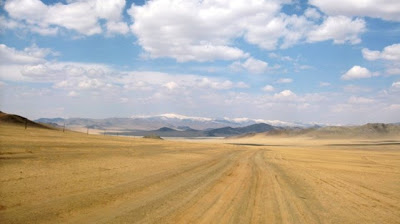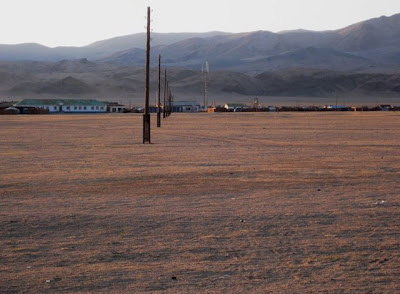 Last week, just after our rousing concert, I took off for the countryside with Alta, my manager from UB, Undrah, my counterpart in Bayankhongor, and our driver Chuka. Leslie was at home gearing up to go on the road with her concert when I left. So far it's been almost two weeks since we saw each other and we have one more week to go.
Last week, just after our rousing concert, I took off for the countryside with Alta, my manager from UB, Undrah, my counterpart in Bayankhongor, and our driver Chuka. Leslie was at home gearing up to go on the road with her concert when I left. So far it's been almost two weeks since we saw each other and we have one more week to go.You can see all the pictures with detailed captions here.
During the trip we gave presentations about some new procedural and structural changes that have been made to the business program, marketing, and I talked about project management. By the end, Undrah was doing all the presentations, demonstrating what we in the international development game call "capacity building." He learned from Alta and I, then he was able to do it himself, furthering one of my objectives as a Peace Corps volunteer. We also visited with the banks to make sure micro loans were being paid back, and we met with the local mayors to chat about our progresses.


Yaks!
In this village, trash was dumped just outside of town. Notice the horn sticking out of the burlap sack.

Cell phone companies power their towers with solar panels.



The eagle had landed.

Check out this ger placement!

Statues of horses, yaks, goats, sheep and camels were in almost every village we went to. Animals are obviously an important part of Mongolian countryside life.

How to Kill an Animal
In case you're not familiar with how to slaughter an animal in Mongolia, here's a step-by-step tutorial. It's actually pretty cool and, I think, humane.

1. Tie up the animal (or have your buds hold it down), then use your trusty knife to make a small incision.
 2. Stick your hand inside and find the right artery around the heart. Now pinch that until the animal stops moving.
2. Stick your hand inside and find the right artery around the heart. Now pinch that until the animal stops moving.
3. Take your hand out, but leave any clingy guts inside.
4. (not pictured) Skin and gut your little lady. Supper's waiting on you.
Tea Time
If you were wondering how to make tea for guests in your ger, you're in luck. Normally Mongolian's drink milk tea, which is just black tea with a lot of milk cooked in. What's interesting about this time of year is that milk is scarce due to skinny animals who've endured a long winter but don't yet have spring grasses to graze on. The following technique is really only used for black and green tea, not necessarily milk tea.
 1. Boil some water and put in loose tea. Mix well.
1. Boil some water and put in loose tea. Mix well. 2. Scoop the tea through a mesh screen into the pot.
2. Scoop the tea through a mesh screen into the pot. 3. Pour tea for your thirsty guests.
3. Pour tea for your thirsty guests. 4. Put the wok away and cover the fire.
4. Put the wok away and cover the fire.2. Next use a stick to spin the rocks. As they spin, the ground grains fall out the side.



3. Serve with a specially prepared Mongolian yellow fat, water and sugar.

This adroit and pleasant 72 year-old gentleman has been using this technique for 15 years. His parents were farmers, but he took other jobs during the planned economy. When the government changed to the market economy in the early 1990's he used his knowledge to start his own small farm. He has 10 children, 3 of whom are still in college earning degrees in business, computer engineering and accounting, so he said he was working hard to get them through. He is quite strong, but well worn by life.
 His plot of land is few acres just outside of town, and he works it all by himself. This year, he's adding another 100 sq. meters or about another third of his field. He's also a motorcycle repairman, among many other things. It was a pleasure to meet him.
His plot of land is few acres just outside of town, and he works it all by himself. This year, he's adding another 100 sq. meters or about another third of his field. He's also a motorcycle repairman, among many other things. It was a pleasure to meet him.
 It was quite a long trip, but I was happy to learn many new things about life in Bayankhongor's northern villages. To see all the pictures from the trip, please click here.
It was quite a long trip, but I was happy to learn many new things about life in Bayankhongor's northern villages. To see all the pictures from the trip, please click here.


















2 comments:
I love seeing photos of the countryside! The dearth of trees really makes for some spectacular photogrpahy - just land and sky. I looked through your photos on FB and any notion of me being able to survive just about anywhere went out the window with the sheep's head. I am not much of a meat eater, and that would take some major fortitude that I may not possess. Nathan, you certainly have more guts than I!!
Not sure my comment got sent - can't get the hang of this new technology!!
Thoroughly enjoy your blog -- always interesting reading. I most certainly hope you are both wired for sound and tape recorders upon re-entry into the land of conspicuous consumption. That would make some interesting reading!! See how more than half the world survives is a real eye-opener.
Post a Comment